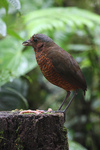Genus Grallaria

White-throated Antpitta - Its natural habitat is subtropical or tropical moist montanes.
Moustached Antpitta - It is found in Colombia and Ecuador. Its natural habitat is subtropical or tropical moist montane forests. It is threatened by habitat loss.
Grallaria andicolus - The Stripe-headed Antpitta is a species of bird in the Formicariidae family. It is found in Bolivia and Peru. Its natural habitat is subtropical or tropical moist montanes.
Santa Marta Antpitta - Its natural habitat is subtropical or tropical moist montanes. It is threatened by habitat loss.
Chestnut Antpitta - Its natural habitat is subtropical or tropical moist montanes. It is threatened by habitat loss.
Bay Antpitta - Its natural habitats are subtropical or tropical moist montanes and heavily degraded former forest.
Pale-billed Antpitta - Its natural habitat is subtropical or tropical moist montanes.
Grallaria chthonia - The Táchira Antpitta reaches a length of 17 cm. Its upperparts are brownish. Crown and nape are coloured grey. The mantle has black barrings. Throat and ear coverts are brown. It is further characterised by a white malar stripe. The lower belly is whitish, the flanks and the breast have grey barrings.
Ochre-striped Antpitta - Its natural habitat is subtropical or tropical moist lowland forests.
Elusive Antpitta - Its natural habitat is subtropical or tropical moist lowland forests. It is threatened by habitat loss.
Red-and-white Antpitta - Its natural habitats are subtropical or tropical moist montane forests and heavily degraded former forest.
Rufous-faced Antpitta - Its natural habitats are subtropical or tropical moist montane forests and heavily degraded former forest.
Yellow-breasted Antpitta - It is found in Colombia and Ecuador.
Giant Antpitta - Rare and somewhat enigmatic, is known only from Colombia and Ecuador. It is presumably a close relative of the similar Undulated Antpitta, G. squamigera, which occurs to the south of G. gigantea. The Giant Antpitta has three subspecies, one of which might be extinct.
Grey-naped Antpitta - Its natural habitat is subtropical or tropical moist montane forests.
Scaled Antpitta - It is found in Bolivia, Brazil, Colombia, Costa Rica, Ecuador, El Salvador, Guatemala, Guyana, Honduras, Mexico, Nicaragua, Panama, Peru, Trinidad and Tobago, and Venezuela. Its natural habitats are subtropical or tropical moist lowland forests and subtropical or tropical moist montane forests.
Plain-backed Antpitta - It is found in Ecuador, Peru, and Venezuela.
White-bellied Antpitta - Its natural habitats are subtropical or tropical moist montane forests and heavily degraded former forest.
Cundinamarca Antpitta - Its natural habitat is subtropical or tropical moist montanes. It is threatened by habitat loss.
Brown-banded Antpitta - Its natural habitats are subtropical or tropical moist montane forests and plantations. It is threatened by habitat loss.
Chestnut-naped Antpitta - It is found in Colombia, Ecuador, and Peru. Its natural habitat is subtropical or tropical moist montane forests.
Rusty-tinged Antpitta - Its natural habitats are subtropical or tropical moist montanes and heavily degraded former forest.
Tawny Antpitta - It is found in Colombia, Ecuador, and Peru.
Grallaria ridgelyi - The new species is a large ground antbird with a striking head pattern showing tufts of white plumes beneath the eyes. It has a song similar to the hooting of the Rufous-banded Owl.
Chestnut-crowned Antpitta - It is found in Colombia, Ecuador, Peru, and Venezuela.
Bicoloured Antpitta - Its natural habitat is subtropical or tropical moist montane forests. It is threatened by habitat loss.
Rufous Antpitta - It is found in Bolivia, Colombia, Ecuador, Peru, and Venezuela.
Undulated Antpitta - It is found in Bolivia, Colombia, Ecuador, Peru, and Venezuela.
Variegated Antpitta - Its natural habitats are subtropical or tropical moist lowland forests and subtropical or tropical moist montanes.
Watkins' Antpitta - Its natural habitat is subtropical or tropical dry forests.



